The Ganzfeld effect is a form of visual sensory deprivation. The idea is to give the open eyes a blank visual field of uniform color. Since there is nothing for the eyes to see, the brain cuts off the unchanging input, and often manufactures its own images – these may be thought of as mild hallucinations. Personally, I haven’t experienced any vivid hallucinations via a Ganzfield, but I find the effect to be rather relaxing. I’ve found that a Ganzfeld is very good for helping to eliminate excess chatter in the mind, especially when practicing meditation.
One common meditation technique involves cracking the eyes just barely open, so that even though your eyes are open, you can’t really see anything. There are two purposes for this technique: 1) it’s easier to stay awake with the eyes open and 2) when the eyes are closed, the brain goes into the idling alpha wave rhythm. When you meditate, one aim is to generate alpha with the eyes open; this isn’t easy, because in typical settings, there are too many distracting things for your eyes to see. I find it easier to stay awake when I use Ganzfeld goggles than when I meditate with my eyes barely cracked open.
A common technique for creating a “Ganzfeld goggles” is to cut a ping pong ball in half, and then place one half over each eye. While this technique is cheap, and relatively easy, it’s not particular comfortable, as the edges of the cut halves tend to be sharp. Also, they’re easily damaged. I’ve devised alternate cheap and easy method of building Ganzfeld goggles, which is more comfortable and durable, and better than an expensive commercial alternative.
My take on Ganzfeld goggles starts with a pair of cheap swimming goggles. I bought a pack of 3 at Big Lots for $7.
It’s important to use large goggles with a bubble lens as above. What we are looking for is to have a big enough lens that when we’re wearing them, the edges are basically outside of the visual field. Next, we need a can of frosting spray:
You can find glass frosting spray in the spray paint section of most hardware stores. I also tried white paint, but frosting spray is better, because it lets more light through, and filters the light more evenly. Remove the seals and straps from your goggles, and spray on the frosting
Be sure to spray both the outside and inside of the goggles. 2-3 coats are needed to achieve a sufficient frostiness. Wait about 10 min between coats. Once they’re dry, reassemble your goggles.
Your Ganzfeld goggles are now ready to use.
I won’t go into detail here on how to use Ganzfeld goggles, because you can find plenty of articles via Google. However here are some basics:
Find a quiet room, and lay down in a recliner or on a bed. Keep your eyes open, and relax. You may want to try auditory sensory deprivation, as well. Since it’s hard to find a completely quiet place, another way of decreasing auditory distractions is to listen to white, pink, or brown noise through sound-isolation headphones. You can make noise files easily using Audacity, a free audio editor. Here is a tutorial on YouTube for how to generate white/pink/brown noise. Although the video says you can use any version of Audacity, only Audacity 1.3+ can generate pink and brown noise. Audacity 1.2.x can only generate white noise.
You can also try audio brainwave entrainment, using binaural beats. Some people like alpha wave entrainment; personally, I find 7 Hz theta wave entrainment to work best. There SBaGen and BWGen are two free programs for generating binaural beats. An excellent commercial software, which is a lot more flexible, and can generate other waveforms, such as isochronic beats, is Neuroprogrammer. STAY AWAY FROM I-DOSER. The author makes ridiculous, fraudulent claims, and the program is just a rip-off of Jim Peter’s GPL’ed SBaGen code.
If you want to use the goggles to enhance your meditation, simply wear them while practicing your normal meditation techniques. Instead of keeping your eyes barely cracked open, you can keep them fully open, half open, or whatever way feels most comfortable. Again, I won’t go into detail about meditation techniques, but a good method for beginners is Counting Meditation. Sit with your spine straight and tailbone slightly elevated by a pillow. Inhale and exhale deeply and slowly through your diaphragm (you expand your belly, rather than your chest during breathing) while counting your breaths. As you relax, your breath will naturally slow down. If you lose count due to being distracted, simply start over. Eventually, you will be able to get the count higher and higher before you lose your concentration.
Another experiment you can try is to play with colored light sources. For instance, you can sit in a room which is lit by a red lightbulb. I’ve found that even sitting in the dark with some colored LED’s works. If you want to attach the LED’s directly to your goggles, you can diffuse them with ping-pong balls. Just cut a ping-pong ball in half. Hot glue an LED into each one, pointing away from the opening. Then hot glue the ping pong ball halves onto your goggles.
While I don’t experience hallucinations when using the goggles, they are quite relaxing, and really do enhance my meditation practice. With the vision blocked, your brain shifts its attention more to your other senses. If I use them without listening to my entrainment tracks, I become much more aware of the ringing in my ears that my brain normally filters out.
I’ve also played with an alternate pair, which I painted with several coats of black paint. The idea is to completely block out the light, so it’s like you’re sitting in a pitch black room of absolute darkness.
I actually prefer this black pair when meditating. Your brain naturally produces occipital alpha waves when you close your eyes. The idea of meditating with eyes open is that it forces you to produce the alpha waves by meditation only. However, meditating with eyes open is visually distracting. Wearing the black glasses allows you to eliminate visual distractions while meditating with eyes open.
If you find swimming goggles to be uncomfortable, you can try using safety glasses. I bought a pair at my local 99 cent store. You can also find them cheaply at HarborFreight. Simply pop out the clear lens, spray with frosting spray, and then reassemble.
I find the safety glasses to be a bit more comfortable for long sessions. The downside is that in order to avoid peripheral vision from ruining the ganzfeld, you have to wear them fairly close to your eyes, and avoid rolling your eyes up or down.
Mindmodifications.com has an interesting article about the Ganzfeld effect: MULTIMODAL GANZFELD GIVES MILD HALLUCINATIONS
They also have detailed instructions on how to build the goggles out of ping-pong balls, should you want to try that version, as well.
Enjoy your Ganzfeld goggles, and feel free to leave feedback about your experiences below, or to tell of any enhancements you devise.
Related Post: Build Ganzfeld-style Photic Goggles (AVS Lightframes)
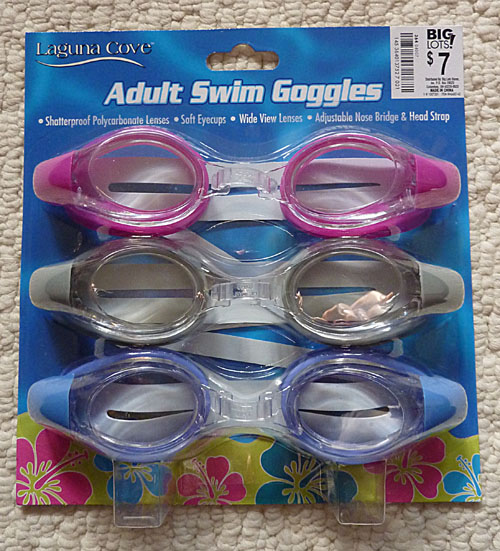
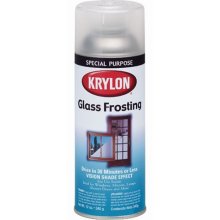
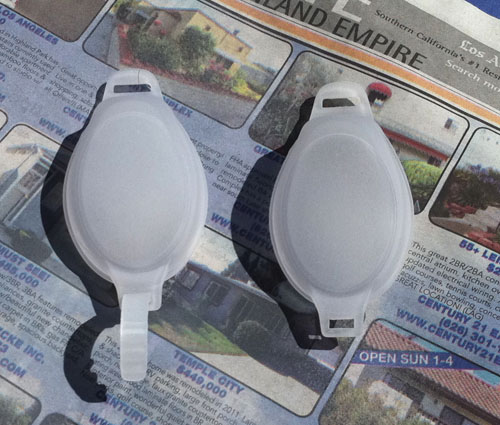
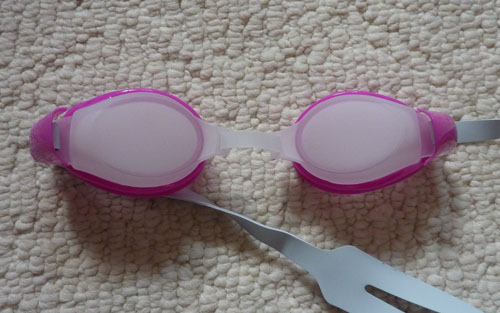
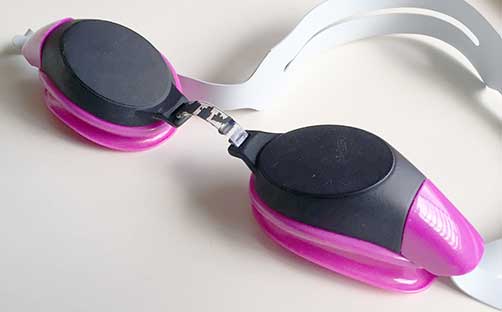
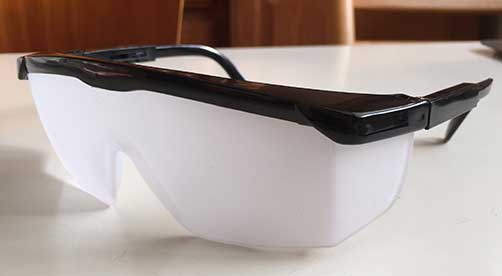
Great idea! I just bought some swimming goggles from Amazon, and I hope they’ll do the trick. One concern is that the “corners” of the lenses will be visible, and so the field won’t be uniform.
What do you think about using a single-lens goggle (such as the “Paulson Shields Bubble Goggles” on Amazon)?
My goggles have lenses that are big enough that the corner’s aren’t visible as long as I’m not purposely looking at them.
I haven’t tried the bubble goggles. Although they might have a larger field of view, I wonder if light will bleed in around
the edges. They don’t appear to seal tightly.
Hmm I meant the rim of the flat lens in front. I ordered some that look much like yours, and for me that rim ruins the effect. Maybe I’ll try the Paulsons!
Hmm. I can’t see the rims in mine. did you put multiple coats of the frosting on both the inside and outside?
https://dl.dropbox.com/u/64863754/IMG_20121013_130052.jpg
https://dl.dropbox.com/u/64863754/IMG_20121013_130116.jpg
Yours don’t look like that? I’m admittedly the least handy person who ever lived, so it’s no surprise if mine didn’t turn out as well as yours 🙂
Yours look under frosted. You shouldn’t be able to see anything through them. I can see the surrounding room through yours (first photo) . Use several thick coats on both the outside and inside.
If we’re looking at the same thing, that apparition on the right side of the lens is the piece of plastic where the eyepiece connects to the strap. But no harm in frosting more — I can always just use brighter light!
Try these:
http://www.instructables.com/id/Ganzfeld-Hack-Your-Brain-the-Legal-Way/?ALLSTEPS
Awesome idea with the frost spray (I didn’t even know such spray existed..!). This a clever improvement over the basic ping-pong ball version.
Thanks a lot for sharing this.
Hi, I tried the Gansfeld method, but my eyelashes kept distracting me any time I blinked. This happen to anyone else or have I jut got unnaturally long eyelashes? 🙂
Thank you for this great idea. I found the sharp edges of the ping pong balls quite annoying. I also found it difficult to keep the spheres in place without adding shades because of the sellotape.
What is the main difference between using frost spray as opposed to black spray? I want to completely remove all visual ability while still letting the eyes open… is this possible with the frosted application? Thank you. Also has anyone here tried this with ski goggles?
Black spray puts you into complete darkness. Frost spray puts you into a monochrome light field, which is the traditional Ganzfeld effect.
Thank you..I kind of figured that out (not sure why it originally eluded me). I am working on a pair of swim goggles, have applied a few coats of flat black paint.. so far so good!
Thanks! I was interested to see if I can build a set of goggles that will manage SAD seaonal affective disorder as good or better than the expensive therapy lights.